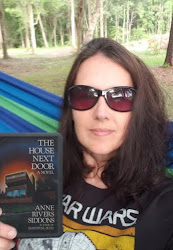Heather Massey is taking over Book Den today to discuss a really cool steampunk topic - automatons! Don't forget to check out her generous giveaway!
Automatons are a big staple of the steampunk genre. They have their roots in real life automata, which are
“non-electronic moving machines” and have a history dating back to the ancient Greeks. Automata were made into a variety of forms, but what I’d like to focus on is the idea of steampunk automatons fashioned after the human form.
These characters are, in a word, spooky.
The idea of Victorian-era robots driven by steam or clockwork power (or other sources, depending on the story) is one of steampunk’s most powerful and riveting manifestations. Automatons play a variety of roles in steampunk, from servants to soldiers to laborers. In some stories, they are part of the backdrop; in others, they play more key roles.
While often simple in design and purpose, it’s dangerous to underestimate them. They are often controlled by a nefarious villain intent on taking over something or someone. Not all automatons are deadly, but I’d keep a close eye on them all the same.
A huge part of the appeal is that automatons are just so…primitive. Scary. Unpredictable.
For one thing, they don’t always have a streamlined appearance like modern robots. That, of course, is where the Victorian aesthetic comes into play. Despite their rough-hewn nature, they’re larger-than-life and pretty to look at—well, some of the time. But even an automaton that has a patchwork appearance and/or is a downright mess of cogs and oversized rivets possesses a unique type of beauty.
Because automatons are so primitive, they often move slowly, in a clunky sort of fashion. They are the steampunk cousins of zombies, only without the dripping blood and guts. Unlike zombies, automatons are hard to punch, since they’re usually made of metal. And they’re intrepid. As long as they don’t run out of power, they’ll just keep coming at you if so ordered.
Let’s face it—automatons made in the human likeness are creepy. Often, they have an eerie, vacant stare that is deliciously unnerving. Seeing but not seeing, if you see what I mean. They leave a person wondering how much they actually know about the world around them. In that sense, they are a great way to process our fear of the unknown and/or to explore the Other. We can project so much of our feelings onto them because they make wonderful blank slates. Fear of the unknown. Fear of technology. Conversely, hope for an exciting future or the triumph of science.
I hope you’ll acquaint yourself with an automaton or two if you haven’t already. A few notable books featuring automatons include:
The Bookman
(Tidhar Lavie)
The Affinity Bridge
(George Mann)
Whitechapel Gods
(S.M. Peters)
The Steam Man of the Prairie and the Dark Rider Get Down: A Dime Novel
(Joe R. Lansdale)
Boilerplate: History’s Mechanical Marvel
(Paul Guinan & Anina Bennett)
The Strange Affair of Spring Heeled Jack
(Mark Hodder)
Steamrolled
(Pauline Baird Jones)
Like Clockwork
(Bonnie Dee)
Soulless
(Gail Carriger)
The Narrows
(Alexander Irvine) (Actually, this story features golems, but who’s counting?)
Now for a giveaway! Leave a comment for this post and be entered for a chance to win
DREAMSPELL STEAMPUNK, Vol. 1, a steampunk anthology from L&L Dreamspell.
(Hint: three of the stories feature automatons!). Winner chooses format (PDF, Mobi, or ePub).
Update: The contest is now closed.
To make it more fun, here’s a question for you:
If you could design an automaton to do anything you desire, what would that be?
Be sure to leave contact
information (blog address or email address or automaton serial
number...) along with your comments so Heather has a way to contact the
winner!
About the Author
Heather Massey is a lifelong fan of science fiction romance. She searches for sci-fi romance adventures aboard The Galaxy Express. She’s also the author of Once Upon a Time in Space, an erotic sci-fi romance. Her latest release is “Steambot Rampage,” a steampunk romance short story. When she’s not reading, she’s watching cult films and enjoying time with her husband and daughter.
To learn more about her published work, visit
www.heathermassey.com.














